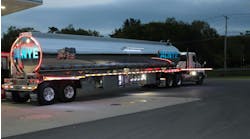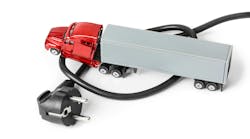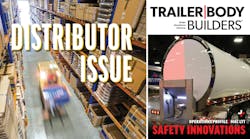The term “work culture” can come across as a little squishy, especially when shops are busy fabricating, assembling, and maintaining serious pieces of commercial-grade transportation equipment. But in at its most basic terms, work culture is simply the attitudes, beliefs, and behaviors that combine to create a particular atmosphere in a workplace—whether the shop floor, parts counter, or the office—according to career site Indeed. And when the overall atmosphere can be the difference between which skilled workers want to stay with a company and which customers want to return, shop culture suddenly becomes very tangible.
The benefits that play into a positive shop culture and convince technicians to stay have been well documented. According to WrenchWay’s 2023 Voice of Technician Survey, some of the most important parts of a shop’s culture for technician retention is offering paid vacation, paid training, and proper equipment, with 96%, 92%, and 99% of techs respectively reporting these as benefits they look for when applying for jobs.
But there’s more to positive culture than individual benefits. A shop’s policies and workplace management are just as critical, according to Jim Saeli, workshop instructor and inspector for shop management consultancy DRIVE on TBB’s sister site Ratchet + Wrench.
“The implementation of well-defined policies and procedures significantly impacts the culture of a repair shop,” Saeli explained in a recent column. “These elements create a structured and professional environment that fosters trust and reliability.”
And in turn, a shop’s playbook of policies and procedures needs to reflect a shop’s culture which then impacts customer satisfaction, employee morale, and overall success, he noted.
Stacy Conner, president and founder of Equipment Experts Inc., suggested that her company’s prioritization of honesty, reliability, customer satisfaction, trust, and dependability in their culture has led to smoother hiring practices, where their employees help bring in new talent.
“We’ve got several pairs of wives and husbands that work here, and we had two sets of brothers and several partners that work together,” Conner said. “They liked the environment so much they brought people on.”
To expand upon how a company can establish policies, or a ‘playbook’ that reinforces the culture, Saeli emphasized the need to standardize customer service processes, employee policies, operational policies, and procedure and workflow systems.
Making a shop policy playbook
Customer service policies: One of the first policies Saeli recommends codifying to create a positive workplace atmosphere is for customer service, as little sours the mood in the shop faster than an angry customer. He recommends that shops highlight transparency in their customer relations, and back it up with clarity on repair costs, timelines, and procedures with customers.
“This involves providing detailed estimates before beginning any work and updating customers regularly on progress,” Saeli said.
Shops should also be sure to promote the warranties they offer on parts and labor, both to show that they stand behind their work and to promote customer confidence, Saeli explained. A robust feedback system, whether that’s through follow-up calls, surveys, or an online comment section, is also helpful to fine-tune your shop’s operations. And, of course, with a system for feedback must come an understanding on how to handle customer feedback, both positive and negative, sometimes in a public forum.
Employee policies: As WrenchWay’s Voice of Technician survey noted, 92% of diesel technicians look for paid training at a shop. This makes incorporating training and development your shop expectations a critical investment, from continuous repair, safety, and technology training for techs to customer service training for your front-desk employees, not to mention management training for shop owners and managers, too. Saeli also emphasized the importance of codifying employee expectations, so that everyone knows what’s expected of them every day.
“Establish a code of conduct that outlines expectations for professionalism, punctuality, and workplace behavior,” he said. “This promotes a respectful and productive work environment.”
Operational procedures and workflow: Finally, ensuring your shop’s reputation for quality is in your playbook will help your employees uphold your standards while streamlining their workflow. Quality control options, whether that’s required inspections before returning a vehicle to a customer or repair and estimate reviews, are always a good way to do this, as well as having established daily workflows, tasks, and inspection checklists. Saeli also recommended having an organized inventory to make sure your techs have the tools they need to meet your shop’s standards.
On the client side, walking your customer through your repairs and process both before and after a job both ensures your standards and adds to your customer’s confidence, and thus your reputation.
“Clearly outline to your customer the steps involved in the repair process, including any necessary diagnostics, part replacements, and testing,” Saeli explained. “This needs to be communicated in a way that anyone can understand. Transparency is key here.”
By including these baseline expectations in your policies, your culture will benefit from having clear expectations and knowing the proper people and channels to use when challenges arise. These positive effects will ripple outward from your employees to your customers.
“By focusing on customer service, employee welfare, and operational efficiency, shops can create a positive environment that benefits both customers and employees,” Saeli concluded. “Ultimately, a well-managed shop that adheres to strong policies and procedures is well-positioned for sustained success and growth in the community.”
More facilities, more challenges
When it comes to managing multiple locations, it’s important that standards are aligned to provide consistent performance—but this isn’t always easy. Turnover throughout the industry creates a constant churn of new faces. And these new folks might swear they know better than than the boss and will continue to do things as they did at their last job, or, as they might say, “the right way.”
When skilled workers and technicians go rogue and cut corners, their performance might appear to show promise. Ultimately, however, this goes against the policies put in place to best serve the customer. This can even include seemingly little things: For instance, a customer who has visited another dealership—or even another shop in the same group—for maintenance or repairs might expect protective paper over the floormat, or a complimentary fluids check. Whatever the service, if customers’ standards aren’t met, they feel a little let down.
According to Peter Cooper, director of Operations for Merx Truck & Trailer, failing to deliver consistently stellar customer service can keep him up at night, he explained at Fullbay’s 2024 Diesel Connect conference.
He emphasized shops should train employees and build a system “so each customer is taken care of—and each customer gets the same experience whether they’re at this store or that store.”
When establishing shop standards and workflows that can be copied across locations, management should also ensure technicians understand the efficiency and service benchmarks they need to reach. Once they do, this leaves leadership to grow their business and manage high-level challenges.
“Having some systems in place allowed us to have our basics covered so that we could focus on the other issues going on during COVID,” explained Jessica Wendt, owner of HM Repairs and Services.
With strong systems providing clear, standardized expectations that employees are rewarded for meeting, shops can not only reap the benefits of efficient operations, but a strong reputation that brings in more business.
“[Customers] know they have a timeline, they know that we’re going to be there, and that we’re going to do a good job,” said Jennifer Wilson, co-owner, Inland Empire Fleet Maintenance. “That builds your reputation. They’re not coming to you for cost, they’re coming to you because you do what you say you’re going to do.”
Streamline and systemize
The first step in creating order out of chaos is to know where systems are most needed.
“I would encourage you to think about the problems that you have going on within your company and see if there’s patterns or constant issues surrounding, for example, unique parts and parts ordering,” Wendt stated.
Then come up with a system that is trainable to your staff, repeatable across your locations, and will solve the needs of the company, she said. As a side benefit, establishing standard operating procedures will ease training and onboarding, too.
Wendt said that to standardize HM Repairs and Services’ parts ordering and organization process, they created a separate Parts Request Form and Parts Return Form.
Before moving to their new system, Wendt described how she would often use sticky notes to keep track of parts requests. While quick and easy, the downside was that she’d need to go digging through the trash whenever a technician would return to ask when the part was going to arrive or needed to add other details.
Now, Wendt utilizes a specific form that includes the service order number, the customer, the unit, the part number, and more.
“A lot of times this gets expanded into what price I was going to pay,” Wendt explained. “Once I told the customer what I was going to charge him for [the part], and I would come back to this later and be able to reference that.”
Wendt also established a form for parts returns, which she said not only helped them track their assets but secure vendor credits.
“We order tons and tons of special-order parts on a daily basis,” she stated. “So, it’s important to make sure that if those parts need to go back to the vendor, that we’re able to make sure that we’re getting our money back for those parts and that they’ve been returned.”
And parts are far from the only element of HM Repairs that Wendt has systemized—the shop also uses a flow chart for new service writers to understand where to place estimate values, and a job board to show technicians what jobs they’re working on and their urgency level. All of which helps keep the shops’ gears turning smoothly.
Managing resistance
Of course, processes and culture are only helpful if employees use them. But clear standards and expectations also make it easy for shop managers and technicians to know when that culture is not being met, and the potential consequences.
“If there’s any type of negativity or toxicity of any kind, that’s an immediate threat,” said Ashley Sowell, co-founder of Integrity Fleet Services. “One person can completely unravel any amount of good that you’ve done.”
To deal with this, Sowell advised that managers first speak with the technician. If the problem is simply a lack of skill or equipment, then they can make a plan “to get them back on the right track and back into your culture.”
But if it’s a problem of character, then there needs to be a change in tactics.
“Then you need to have that conversation of ‘Look, you knew when you started here that our culture is this,’” Sowell advised. “If you feel like you no longer are aligned with that vision, then we’re going to have to have a very different conversation.’”
This kind of discussion requires firmness, Sowell explained, or else other employees may note this shift in attitude and respond accordingly, to the detriment of shop morale and productivity. But on the other side of the coin, if a shop can establish and maintain positive processes and culture, they’re likely to see just the opposite, resulting in a shop technicians want to work in and that customers want to come to.









